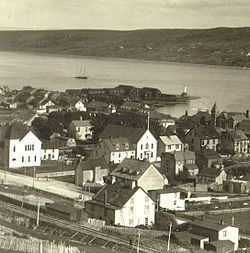Incorporated July 10, 1945 Postal code span A0A Population 3,074 (2006) | Settled 1610 Elevation 16 m (52 ft) Area 33.71 km² Local time Thursday 10:40 AM | |
 | ||
Weather 4°C, Wind W at 24 km/h, 82% Humidity | ||
From grates cove to harbour grace newfoundland canada hd travel channel
Harbour Grace is a town in Conception Bay on the Avalon Peninsula in the province of Newfoundland and Labrador, Canada. With roots dating back to the sixteenth century, it is one of the oldest towns in North America. It is located about 45 km northwest of the provincial capital, St. John's. The town has a population of 3,074 (2006), engaged primarily in fishing and fish processing.
Contents
- From grates cove to harbour grace newfoundland canada hd travel channel
- Map of Harbour Grace NL Canada
- 62 64 harvey st harbour grace
- History
- History briefs
- References
Map of Harbour Grace, NL, Canada
The alternative spelling Harbor Grace was current at one time.
62 64 harvey st harbour grace
History
Harbour Grace was an important port and fishing centre from the earliest days of European exploration of North America and was a thriving seasonal fishing community by 1550, with permanent settlement beginning in 1583 (24 years before the Jamestown, Virginia colony, often incorrectly cited as the first permanent European settlement in North America, and two years before the "lost" colony at Roanoke, North Carolina). The first year-round settler that year was Robert Tossey of Dartmouth, England. The town was named after Havre de Grâce (now Le Havre), France, although it is uncertain whether the name was given by French cartographers, Francis I of France, or early settlers from the British Channel Islands and West Country who were familiar with Le Havre as a common trade destination for fishermen from the Channel Islands.
In 1610, pirate Peter Easton made Harbour Grace his headquarters, and established a fort overlooking the bay. Although it was attacked by the French the following year, the early settlement survived throughout the seventeenth century, with a permanent, year-round population numbering a few dozen, swelling to several hundred during the fishing season. In 1618, Bristol's Society of Merchant Venturers received a charter from King James I of England to establish a settlement near Harbour Grace, "Bristol's Hope", and appointed Robert Hayman as its first Proprietary Governor, a post he held for the next ten years. Back in London at the end of this period in 1628 Hayman published a work of pithy epigrams called Quodlibets which he had written in Harbour Grace — it was the first book written in the new world. The Conception Bay area is referred to in the subtitle of his book not as "Conception Bay" but by its original, though now largely forgotten, name of "New Britanolia".
Over the coming years, control of Harbour Grace became a point of contention between the English and the French. The town, with a population numbering about 100, was razed by the French in 1697, again in 1700, and captured briefly in 1762. Nevertheless, between these attacks, the population grew by 50 percent. By 1771, the population was close to 5,800. By then, however, other colonial towns along the Atlantic coast had surpassed Harbour Grace in population and influence. The town continued to grow and peaked in population in 1921, when the census was taken at 11,458 residents.
As trans-Atlantic aviation became more popular in the 1920 and 1930s, many aviation pioneers, among them Amelia Earhart and Thor Solberg chose to make their crossing from the nearby Harbour Grace airfield due to its proximity to continental Europe. Altogether, some twenty flights left Harbour Grace from 1927 to 1936 in their attempts to cross the Atlantic.
In July 1941, the Royal Canadian Navy established a High Frequency Direction Finding wireless station on the airfield. Consisting of an Operations Building and a Direction Finding shack, the station had an uninterrupted sweep of the northern Atlantic sector and was able to provide bearings on U-boat transmissions and also intercepting enemy radio traffic.
Harbour Grace was one of the first sites that the Royal Canadian Navy was solely responsible for after war broke out. On May 21/45, the Canadian Naval Service approved the closing down and disposal of its facility at Harbour Grace. There is no evidence of the station today.
Following the war, the airstrip was left to deteriorate. In 1977, through the efforts of the Harbour Grace Historical Society, it was restored to a usable condition. In 1999, after years of being considered abandoned, the airstrip was reinstated to official international airdrome status under the designator of CHG2.
Today, Harbour Grace continues its tradition as a fishing and fish processing centre. In addition, because of its rich history and many historical buildings, a small tourist industry is emerging. The Gordon G. Pike Railway Heritage Museum and Park (c. 1881-84) was designated a Municipal Heritage Building in 2006.
